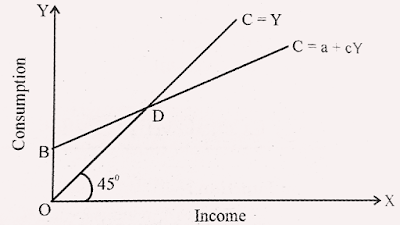BCOM Business Economics | Consumption Function | Determinants of Consumption Function
BCOM Business Economics
Consumption Function and Determinants of Consumption Function
What’s the Consumption function?
-
The consumption function shows the relationship between income and consumption. According to Keynes, it is the Propensity to Consume.
-
It shows the functional relationship between two aggregates that is total consumption and gross national income.
-
Consumption depends upon the level of income. When the income of the person rises, consumption expenditure also rises.
Symbolically:
C= f(Y)
Where C is Consumption, f is Function, Y is Income
The functional relationship between income and consumption can take different forms. In a linear form the consumption function can be expressed as:
C=a+cY
The Above equation shows that consumption is equal to ‘a’ an autonomous consumption taking place when income is zero, plus ‘cY’ a constant proportion of income.
Thus, even if income is zero, the consumption will not be zero but it will be equal to ‘a’
In equation (2) ‘c’ is the Marginal Propensity to consume and t is constant at all levels of income. However, the average propensity to consume falls steadily as income increases.

-
The line C=a+cY is the consumption curve. It indicates that if income falls to zero, consumption does not fall to zero but is equal to OB, the amount OB is ‘a’ in the equation (2), and the line BC represents ‘cY’.
-
In other words, the consumption curve indicates that when income is very low consumption is greater than income.
-
As income rises consumption also rises, At point ‘D’ consumption is equal to income is called the break-even point. beyond point D as income rises consumption also rises, but slower rate because people save a small proportion of his income i.e. Saving.
There are two factors which affect consumption Subjective and Objective are follows:
Objective Factors
- Change in income: Income plays a vital role in deciding consumption expenditure. Higher-income means high consumption and vice versa(inversely).
- Change in rate of interest: Consumption pattern change due to change in the rate of interest. consumption expenditure falls due to a rise in the interest rate and vice versa.
- Change in capital value: Consumption will increase due increase in the capital value of an individual, and consumption will fall due to a fall in capital value.
- Fiscal policy: Consumption pattern changes due to the change in the economic policy of the government i.e. budgeting policy. For example, a rise in the rate of interest leads to a fall in consumption and vice versa.
- Future expectations: The consumption will increase or decrease due to expectations about future income.
- Demographic factors: Demographic factors like the size of the population, age group, etc. will influence the consumption pattern. For example, if the population has a greater percentage of children, the demand for baby goods would high.
Subjective or Psychological Factors:
These are internal factors relay upon personal decisions. According to Keynes, there are eight subjective motives which determine an individual consumption.
- The motive of precaution: People save money for future needs in order to fulfill unexpected expenditures for the future.
- The motive of foresight: People reduce their spending to fulfill future requirements for money. For example, needs for money for higher education, marriage, buying a house, etc.
- The motive of enterprise: People reduce current consumption and save for the aim of investing. Under this motive, people save to invest in a profitable business.
- The motive of calculation: People save to invest in the financial markets like shares, debentures to increase their income.
- The motive of improvement: People reduce their consumption expenditure in the present just to improve their standard of living in the future.
- The motive of pride: As per this motive, people save their money for future generations, and making donations gives them a feeling of pride.
- The motive of independence: Man saves more so as to depict more power and independence.
- The motive of avarice(greed): Some people have a habit of unnecessarily abstaining from consumption.
SY BCOM Business Economics CLICK HERE
BCOM Business Economics PDF
Reference: MHSB and Manan Prakashan


Thanks for notes